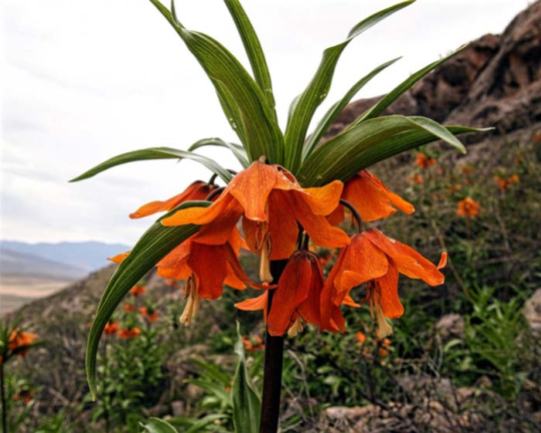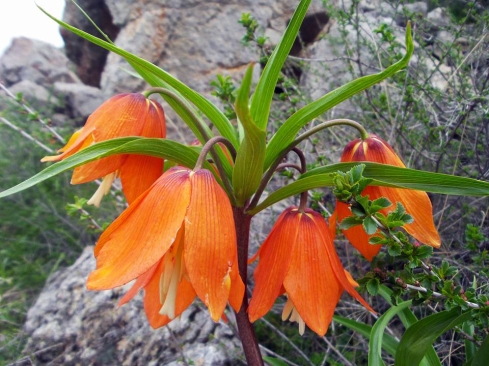Batken is tegion and a city located in the extreme south-west of Kyrgyzstan and consists of four mountain regions located at an altitude of 400 to 5621 meters above sea level. The region was founded in 1999.
The region includes a number of enclaves belonging to Tajikistan and Uzbekistan, formed back in Stalin’s times, when the boundaries of the republics were determined by the government of the Soviet Union. In total there are seven enclaves – very small, no bigger than a farm. The largest enclave of Sokh belongs to Uzbekistan.
The region is not well known even in the republic itself. Most tourists, as a rule, come here from Kyrgyzstan or neighboring republics. nIt is bounded on the east by Osh Region, on the south, west and north by Tajikistan, and on the northeast by Uzbekistan. The northern part of the region is part of the flat, agricultural Ferghana Valley. The land rises southward to the mountains on the southern border: the Trans-Alay Range in the east, and the Turkestan Range in the west. On the territory of the region are several ancient sites of interest including the famous Aigul Moonflower which is the symbol of Batken
The region is lightly populated with as 380,256 by the census of 2009. and mainly agricultural with three quarters the population living in rural area and one quater in the region’s four towns and five urban-type settlements. The majority (76.5 per cent) of the region’s population are Kyrgyz; there are also Uzbeks (14.7 per cent) and Tajiks (6.9 per cent), as well as a few Russians (0.8 per cent), Tatars (0.4 per cent), and Turks (0.2 per cent).
Batken on the Silk Road
The northern part of Batken is part of the Fergana Valley which is today divided between eastern Uzbekistan, southern Kyrgyzstan and northern Tajikistan.

Chinese chroniclers date its towns to more than 2,100 years ago, as a path between Greek, Chinese, Bactrian and Parthian civilisations. It was home to Babur, founder of the Mughal Dynasty, tying the region to modern Afghanistan and South Asia.
The Russian Empire conquered the valley at the end of the 19th century, and it became part of the Soviet Union in the 1920s. Its three Soviet republics gained independence in 1991. The area largely remains Muslim, populated by ethnic Uzbek, Tajik and Kyrgyz people, often intermixed and not matching modern borders. Historically there have also been substantial numbers of Russian, Kashgarians, Kipchaks, Bukharan Jews and Romani minorities
Batken Region was created on 12 October 1999, from the westernmost section of Osh Region. This was partly in response to the activities of the Islamic Movement for Uzbekistan (IMU), with bases in Tajikistan. In 1999 they kidnapped a group of Japanese geologists and in 2000 some American climbers. In the two years, 49 Kyrgyz soldiers were killed. There have been no incidents since, except for an attack on a Tajik border post in May 2006, which was probably connected to drug running
Things to See in Batken Region
Aigultash
Located near Kara-Bulak village in Batken region, this mountain is unique — mysterious endemic flower of Aigul listed in Red Book can be found only here. There is a romantic legend saying the flower has appeared here after a girl named Aigul rushed from the mountain after her lover’s death.
The best time to visit is beginning of April — you will have two weeks, as that’s the period the flower blooms.

Kyrgyzstan has rich biodivesity due to its many mountains, valleys, rivers and lakes and wide range of climatie zones. One plant stands above all the rest and is the symbol of Batken, the with the sonorous and beautiful name – the flower Aigul.
Aigul means moon flower in Kyrgy – “ai” is moon and “gul” is flower. It is said Aigul only blooms duirng one full moon during the year and it only grows on one mountain side on earth. Similar to Aigul flowers grow also in a certain territory of Afghanistan and Tajikistan (other subspecies of hazel-grouse), however, according to experts, they differ both in the color of the buds and in size.
Aigul only grows on the slopes of only one mountain, which is called – Aigultash (“tash” – “stone”). This stony mountain is located about 15-18 km from the city of Batken – the center of the Batken region. In Batken, the month of April of each year always passes under the dictation of the beautiful Aigul, as it is in April that the flower buds open and blossom, giving to the people an indescribable beauty and causing them wild enthusiasm. It is believed that the one who saw the opened flower Aigul, will be infinitely happy. This is not possible for everyone, because the flowering period of Aigul continues only 2 weeks
During the short flowering season in April, the nearby area becomes crowded with large number of tourists and locals. An annualAigul flowering festival is celebrated.
The height of the flower usually reaches 80-90 cm, but some specimens can be much higher. Local residents have found flowers a meter and a half, above your head. Aigul leaves grow along the entire length of the thin stem and in their shape give the flower even greater beauty, grace and grace. The bud itself has a bell-shaped form and about a dozen orange petals of different shades. As one local old resident said, Aigul’s flower is “a real aristocrat of plants worthy of kings.”
According to experts, the flower Aigul gives the first buds only after seven years, and each year their number grows, increasing and in size. So, by the number of flowers, people interested can know the age of the plant. Another unique side of this flower is that it does not grow on the sunny side of the mountain. And one more interesting fact that local residents tell: it turns out that Aigul blossoms only on the full moon!
Do not pick the Aigul flower, it has been discovered that these endemics do not take root in other places, even in the nearby territories of the region. During the flowering of the mountain beauty, local schoolchildren are constantly on duty in the Aygultash Mountains protecting the plants. In addition, grazing is prohibited here, which is also observed by representatives of the “green patrol”.
Aigul are also used in folk medicine: its bulbs are an excellent tool for treating gastrointestinal problems

Legend of the flower Aigul
In ancient times in these places lived one rich man, who had a beautiful beauty daughter named Aigul. Her lover, Kozu Ulan, was known as the first brave among the people. The young coule very much loved each other, and their sincere relations caused respect for fellow villagers. Aigul’s father, who wanted his daughter only happiness, agreed to their union and gave them his blessing.
When couple were to be married soon, a misfortune came for the people. Hordes of enemy troops attacked civilians, and Kozu Ulan among other jigits opposed the conquerors. Soon the enemy was completely defeated, but Kozu Ulan, who was in the forefront of the defending soldiers, was killed.

Djigits of Kozu-Ulan brought his heart Aigul, as she desired. Aigul took with her the heart of her lover, climbed a high rocky mountain and fell to her death. A few days later, in the place where Aigul fell, an amazing flower rose. And the rock, from where the fearless girl rushed, was called Aigultash. Near the mountain Aigultash there is another hill, almost the same height, which is popularly called Kozuulan. Inside the flower Aigul almost always there are drops of dew, which locals call only “tears Aigul”.
Such a beautiful and sad legend lives among the people, which has been passed from mouth to mouth for many years, and perhaps for centuries.
Fergana Valley
The Fergana Valley spreads across eastern Uzbekistan, southern Kyrgyzstan and northern Tajikistan. The valley is ethnically diverse and in the early 21st century was the scene of ethnic conflict.
A large triangular valley in what is an often dry part of Central Asia, the Fergana owes its fertility to two rivers, the Naryn and the Kara Darya, which run from the east, joining near Namangan, forming the Syr Darya river. The valley’s history stretches back over 2,300 years, when its population was conquered by Greco-Bactrian invaders from the west.
Mass cotton cultivation, introduced by the Soviets, remains central to the economy, along with a wide range of grains, fruits and vegetables. There is a long history of stock breeding, leatherwork and a growing mining sector.
The valley owes its fertility to two rivers, the Naryn and the Kara Darya, which unite in the valley, near Namangan, to form the Syr Darya. Numerous other tributaries of these rivers exist in the valley including the Sokh River. The streams, and their numerous mountain effluents, not only supply water for irrigation

Fergana Valley History
As early as 500 BC, the western sections of the Fergana Valley formed part of the Sogdiana region, which was ruled from further west and owed fealty to the Achaemenid Empire at the time of Darius the Great. The independent and warlike Sogdiana formed a border region insulating the Achaemenid Persians from the nomadic Scythians to the north and east. The Sogdian Rock or Rock of Ariamazes, a fortress in Sogdiana, was captured in 327 BC by the forces of Alexander the Great; after an extended campaign putting down Sogdian resistance and founding military outposts manned by his Greek veterans, Alexander united Sogdiana with Bactria into one satrapy.
During the 8th century, Fergana was the location of fierce rivalry between Tang dynasty China and the expansion of Muslim power, leading to the Battle of Talas in 751, which resulted in a victory for the Muslims and the disengagement of China from Central Asia. Two antecedent battles in 715 and 717 had seen the Chinese prevail over Arab forces.mA series of Arab, Persian, and later Turkic Muslim rulers reigned over the Fergana.
Learn More
Aigul flower – Batken sight (Russian Language) -TourKG.com
























